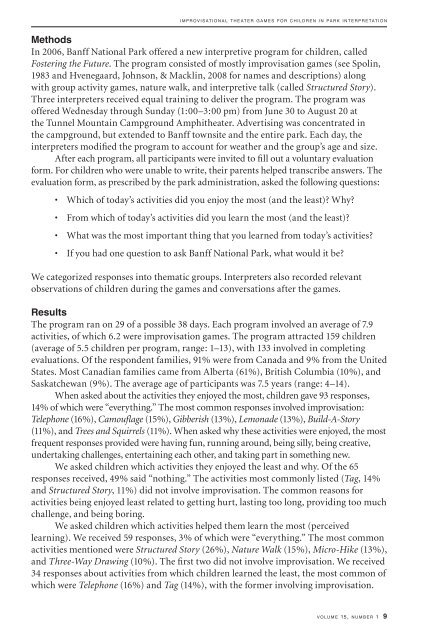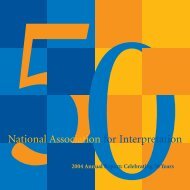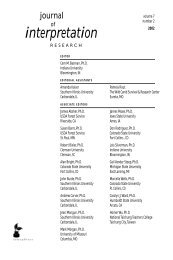interpretation
Volume 15, Number 1 - National Association for Interpretation
Volume 15, Number 1 - National Association for Interpretation
Create successful ePaper yourself
Turn your PDF publications into a flip-book with our unique Google optimized e-Paper software.
i m p r o v i s a t i o n a l t h e a t e r g a m e s f o r c h i l d r e n in p a r k i n t e r p r e t a t i o n<br />
Methods<br />
In 2006, Banff National Park offered a new interpretive program for children, called<br />
Fostering the Future. The program consisted of mostly improvisation games (see Spolin,<br />
1983 and Hvenegaard, Johnson, & Macklin, 2008 for names and descriptions) along<br />
with group activity games, nature walk, and interpretive talk (called Structured Story).<br />
Three interpreters received equal training to deliver the program. The program was<br />
offered Wednesday through Sunday (1:00–3:00 pm) from June 30 to August 20 at<br />
the Tunnel Mountain Campground Amphitheater. Advertising was concentrated in<br />
the campground, but extended to Banff townsite and the entire park. Each day, the<br />
interpreters modified the program to account for weather and the group’s age and size.<br />
After each program, all participants were invited to fill out a voluntary evaluation<br />
form. For children who were unable to write, their parents helped transcribe answers. The<br />
evaluation form, as prescribed by the park administration, asked the following questions:<br />
• Which of today’s activities did you enjoy the most (and the least)? Why?<br />
• From which of today’s activities did you learn the most (and the least)?<br />
• What was the most important thing that you learned from today’s activities?<br />
• If you had one question to ask Banff National Park, what would it be?<br />
We categorized responses into thematic groups. Interpreters also recorded relevant<br />
observations of children during the games and conversations after the games.<br />
Results<br />
The program ran on 29 of a possible 38 days. Each program involved an average of 7.9<br />
activities, of which 6.2 were improvisation games. The program attracted 159 children<br />
(average of 5.5 children per program, range: 1–13), with 133 involved in completing<br />
evaluations. Of the respondent families, 91% were from Canada and 9% from the United<br />
States. Most Canadian families came from Alberta (61%), British Columbia (10%), and<br />
Saskatchewan (9%). The average age of participants was 7.5 years (range: 4–14).<br />
When asked about the activities they enjoyed the most, children gave 93 responses,<br />
14% of which were “everything.” The most common responses involved improvisation:<br />
Telephone (16%), Camouflage (15%), Gibberish (13%), Lemonade (13%), Build-A-Story<br />
(11%), and Trees and Squirrels (11%). When asked why these activities were enjoyed, the most<br />
frequent responses provided were having fun, running around, being silly, being creative,<br />
undertaking challenges, entertaining each other, and taking part in something new.<br />
We asked children which activities they enjoyed the least and why. Of the 65<br />
responses received, 49% said “nothing.” The activities most commonly listed (Tag, 14%<br />
and Structured Story, 11%) did not involve improvisation. The common reasons for<br />
activities being enjoyed least related to getting hurt, lasting too long, providing too much<br />
challenge, and being boring.<br />
We asked children which activities helped them learn the most (perceived<br />
learning). We received 59 responses, 3% of which were “everything.” The most common<br />
activities mentioned were Structured Story (26%), Nature Walk (15%), Micro-Hike (13%),<br />
and Three-Way Drawing (10%). The first two did not involve improvisation. We received<br />
34 responses about activities from which children learned the least, the most common of<br />
which were Telephone (16%) and Tag (14%), with the former involving improvisation.<br />
v o l u m e 15, n u m b e r 1 9












